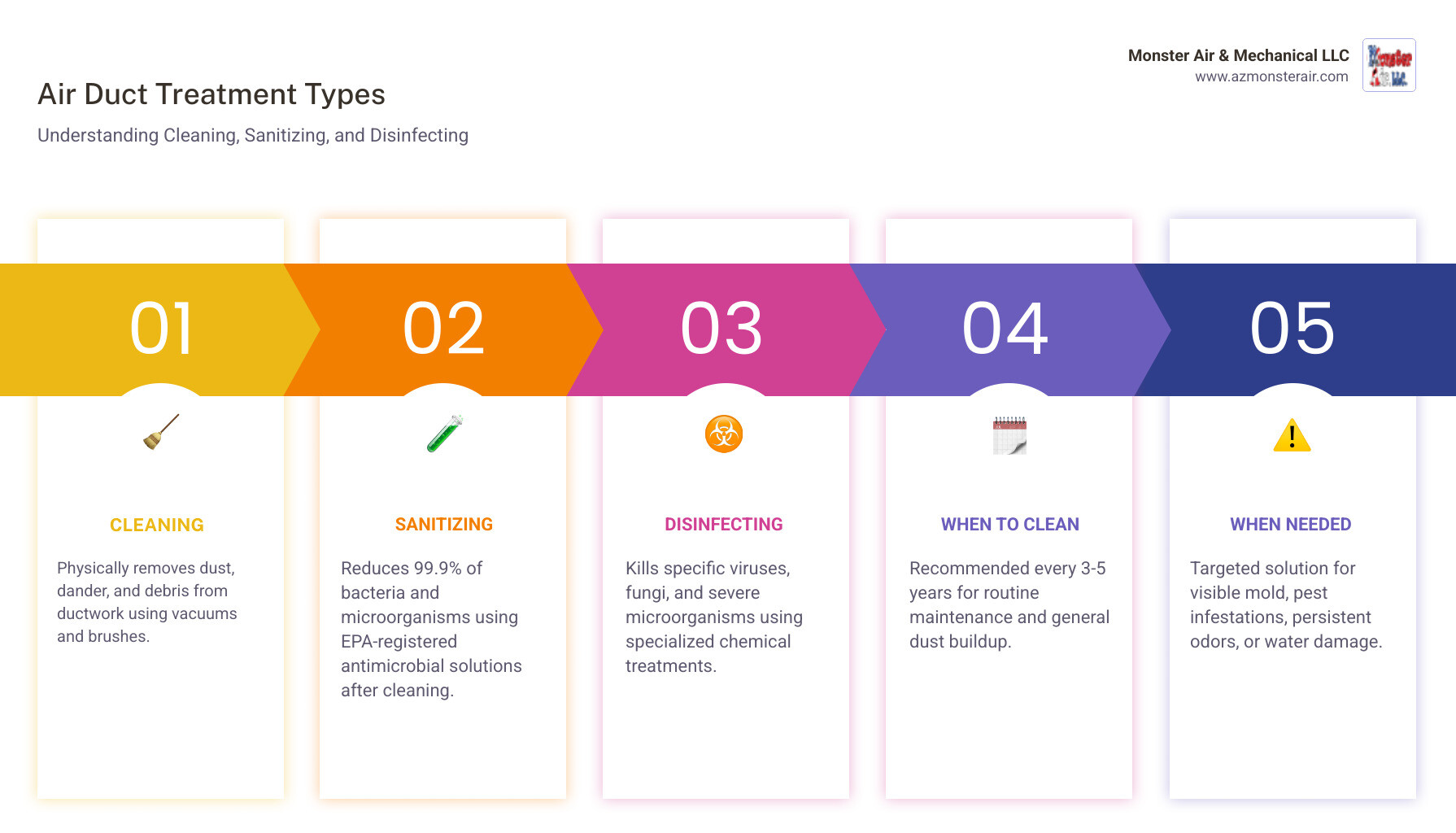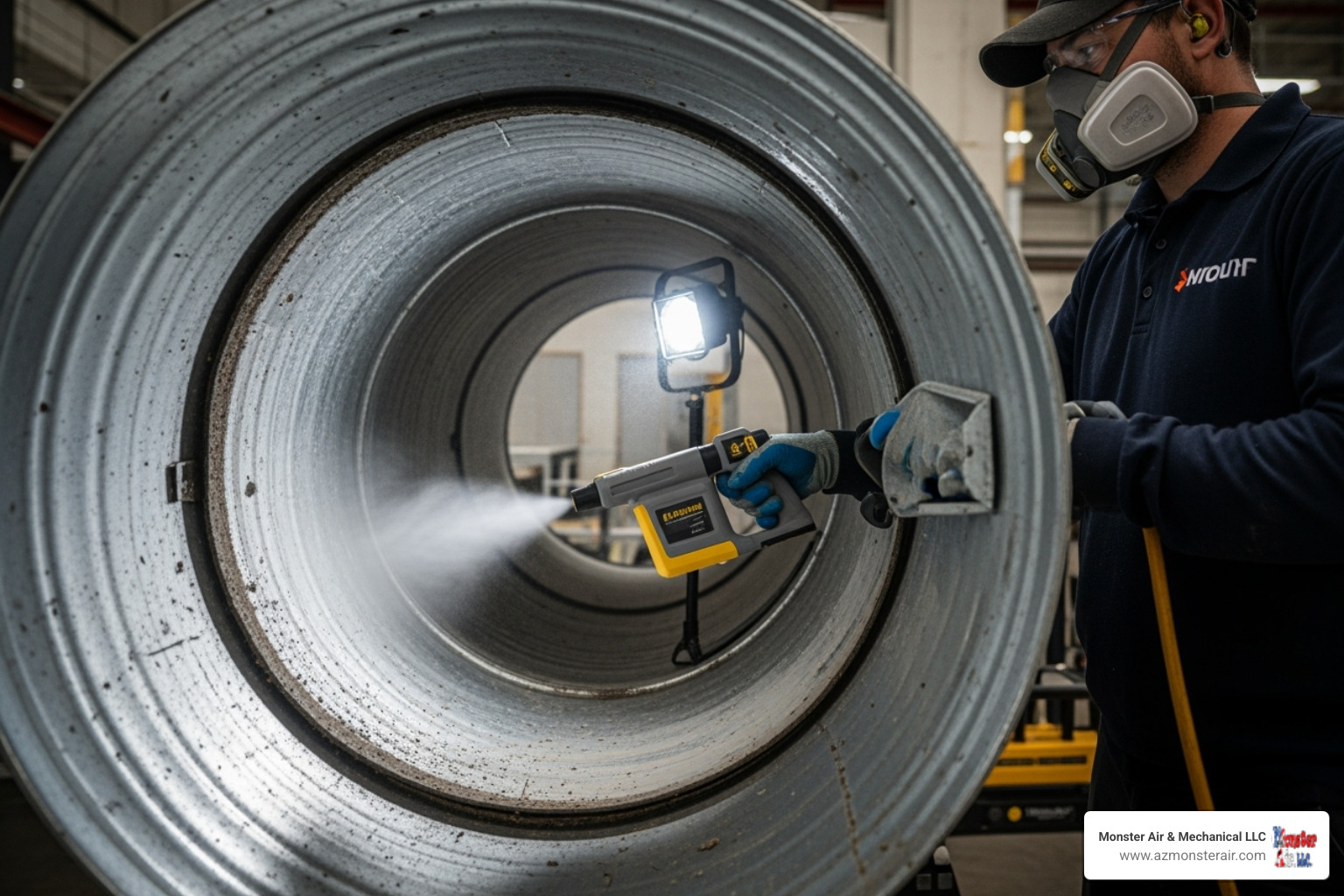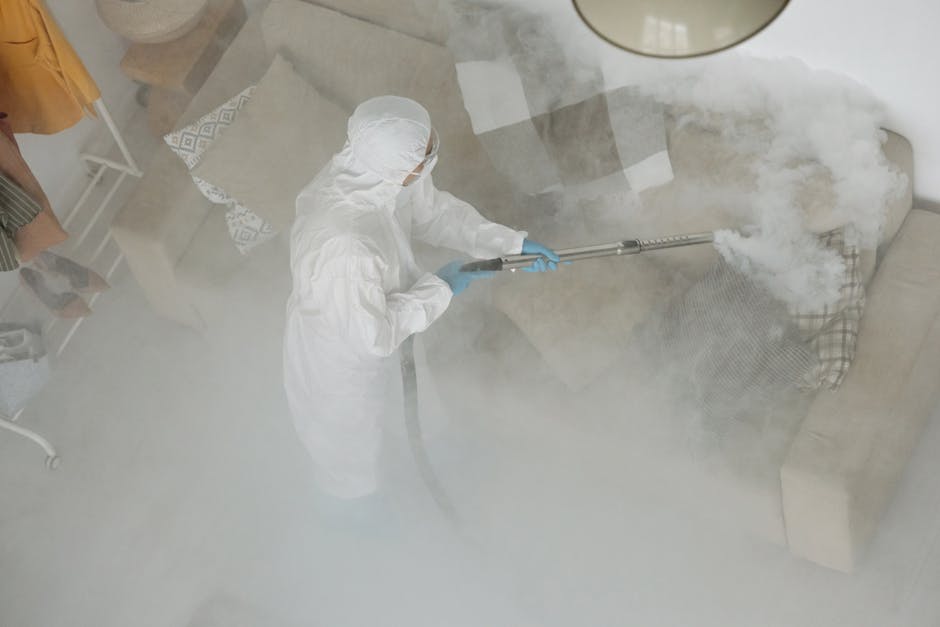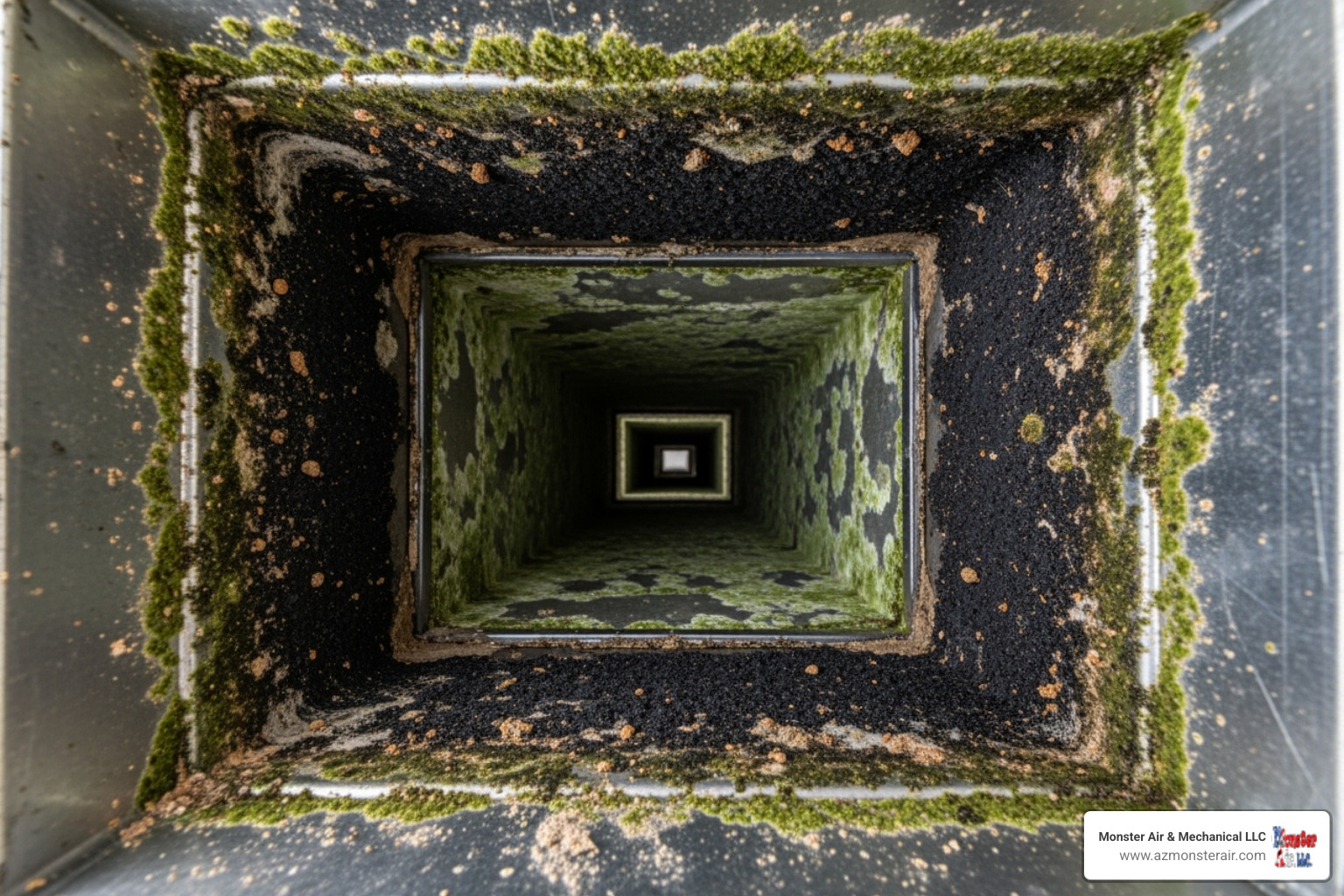Understanding Air Duct Sanitizing: What You Need to Know
Air duct sanitizing is a specialized treatment applying antimicrobial solutions to your duct system to reduce bacteria, viruses, and other microorganisms. But is it necessary for your home, or just an upsell?
Quick Answer: When Air Duct Sanitizing Makes Sense
| You Probably DON'T Need It | You Probably DO Need It |
|---|---|
| Routine maintenance | Visible mold growth in ducts |
| General dust buildup | After pest or rodent infestation |
| Regular HVAC servicing | Persistent musty odors from vents |
| Normal household use | Following water damage to HVAC system |
| Unexplained respiratory issues or allergies |
According to the EPA, indoor air can be two to five times more polluted than outdoor air. Your ductwork can harbor dust, pollen, bacteria, and mold, but that doesn't automatically mean you need sanitizing.
Confusion arises because companies often use "cleaning," "sanitizing," and "disinfecting" interchangeably. They aren't the same: cleaning removes debris, sanitizing reduces bacteria by 99.9%, and disinfecting kills specific viruses and fungi.
Most homes only need a thorough cleaning every three to five years. Sanitizing is a targeted solution for specific problems—not a routine service.
This guide clarifies what sanitizing does, when it's beneficial, how it's performed safely, and how to ensure you get what you pay for.
Think of it this way: don't pay for sanitizing if a good cleaning will suffice. However, when mold, pests, or water damage contaminate your system, sanitizing is an important step toward restoring healthy indoor air.

Cleaning vs. Sanitizing vs. Disinfecting: Decoding the Terminology
Understanding the difference between "cleaning," "sanitizing," and "disinfecting" can save you money and help you make smarter decisions about your home's air quality. While companies often use these terms interchangeably, they are not the same.

Air duct cleaning is the physical removal of dust, dander, pollen, and other debris from your ducts. This process, called source removal, is the foundation of any good duct service. Professionals use high-powered vacuums and specialized brushes to dislodge and extract debris, improving airflow. For most homes, a thorough cleaning is sufficient.
Air duct sanitizing is a secondary step after cleaning. A chemical solution is applied to duct interiors to reduce bacteria by 99.9%. Sanitizing specifically targets bacteria and is a focused treatment for specific problems, not a routine service for dusty ducts.
Air duct disinfecting is the most powerful option, designed to kill specific viruses and fungi. EPA-registered disinfectants eliminate a broader range of germs. Disinfecting is reserved for serious issues like confirmed mold growth or for homes with immunocompromised residents. It is not a routine service and is rarely needed.
The Dangers of Dirty Air Ducts
Why does this matter? Because neglected ductwork can affect your health. indoor air can be two to five times more polluted than outdoor air, and dirty ducts are often a major contributor.
Uncleaned ducts collect allergens like dust mites, pollen, and mold spores. Your HVAC system circulates these particles, leading to constant exposure for allergy sufferers. Dirty ducts can also worsen respiratory issues like asthma, as fine particles irritate airways.
Finally, unpleasant odors like a musty or stale smell often originate in the ducts from mold, mildew, or remnants of a past pest problem.
The bottom line is that cleaning removes physical debris, sanitizing reduces bacteria after cleaning, and disinfecting kills specific germs in severe cases. Knowing the difference helps you choose the right service for your needs.
The Professional Air Duct Sanitizing Process Explained
Professional air duct sanitizing is a detailed, multi-step process requiring specialized equipment and training. We are thorough at every stage to ensure the job is done right.

The process begins with an initial inspection. Our technicians examine your HVAC system, registers, and accessible ductwork for red flags like visible mold or pest droppings. This allows us to create a customized plan. Before starting, we protect your home by laying down drop cloths and sealing all registers to contain dust and maximize suction.
The cleaning phase is a non-negotiable first step. We use high-powered vacuums paired with agitation tools like rotating brushes and compressed air whips to dislodge and capture all built-up dust and debris, removing it completely from your home.
Only after the ducts are clean do we begin the sanitizing phase. We apply an antimicrobial solution using fogging or spraying to achieve full coverage of all interior duct surfaces.
The Application Step in Professional Air Duct Sanitizing
We use professional-grade, EPA-registered disinfectants specifically approved for HVAC systems. A crucial part of ensuring effectiveness is observing the product's required dwell time—the period it must remain wet on a surface to work properly. Our trained technicians follow these guidelines precisely.
After the sanitizer has worked, we perform post-application steps, including system testing to ensure proper airflow and performance. We also ensure proper ventilation so any residual product dissipates safely. Before leaving, we walk you through the completed work. For more information about our comprehensive approach, visit our Duct Cleaning Services page.
The Industry View: Is Sanitizing Necessary and Safe?
Even industry experts don't recommend air duct sanitizing as a routine service. Both the Environmental Protection Agency (EPA) and the National Air Duct Cleaners Association (NADCA) are clear on this point.
The EPA's position is to address the source of contamination, not just the symptoms. They do not recommend routine duct cleaning or sanitizing. For example, if mold is present due to moisture, the moisture issue must be fixed first. NADCA echoes this approach, emphasizing that physical cleaning is the first line of defense. According to their standards, which you can find at NADCA's website, chemical treatments are only for specific situations and are not part of routine maintenance.
Air duct sanitizing makes sense in specific circumstances involving biological contamination that cleaning alone cannot resolve. The single most important preventative measure is to control moisture, as mold and bacteria need it to thrive.
| When Standard Cleaning is Sufficient | When Sanitizing is Recommended |
|---|---|
| Routine dust accumulation | Visible mold growth in ducts |
| Post-renovation dust | After pest or rodent infestation |
| General maintenance | Persistent musty or foul odors |
| Regular household use | Following water damage affecting HVAC |
| Improving HVAC efficiency | Unexplained allergy/respiratory issues |
| Removing pet dander/allergens | Confirmed bacterial or fungal contamination |
The Safety of Air Duct Sanitizing Chemicals
It's natural to have questions about the safety of chemicals used in your home's air system. When performed by professionals, air duct sanitizing is safe. This is not a DIY project.
We use only products that are EPA-registered specifically for HVAC systems. They have undergone rigorous testing for safety and effectiveness when used as directed. For occupant safety, we may recommend that your family and pets temporarily leave the home while the product works and the system airs out. This is a precaution, especially for those with sensitivities.
If you have concerns, we can provide the product's Safety Data Sheets (SDS). DIY sanitizing is a terrible idea, as improper chemical use can be ineffective, damage your system, or release harmful fumes. The risks far outweigh any potential savings. For more on creating a healthier home safely, see our Indoor Air Quality Services.
Key Benefits and Telltale Signs You Need Sanitizing
Your home often provides clear signals when air duct sanitizing is necessary. Recognizing these signs can help protect your family's health and provide peace of mind.

Key warning signs include:
- Substantial visible mold growth: If you or a technician finds mold in your vents, it's a clear sign sanitizing is needed. Mold releases spores that can trigger allergies and respiratory issues.
- Evidence of pest or rodent infestation: Droppings and nesting materials leave behind bacteria and allergens. After pests are removed, sanitizing is essential to decontaminate the system.
- Persistent musty or foul odors from vents that don't disappear after a standard cleaning.
- Unexplained allergy flare-ups or respiratory issues: If symptoms like coughing or sneezing improve when you leave the house, your ductwork could be the culprit.
- After water damage or a leak affecting the HVAC system, as residual moisture creates a breeding ground for mold and bacteria.
Top Benefits of Professional Air Duct Sanitizing
When done professionally, air duct sanitizing creates a healthier living environment with several key benefits:
- Improved indoor air quality: Sanitizing reduces bacteria and mold spores, which is especially beneficial for children, the elderly, and those with compromised immune systems.
- Odor elimination: Instead of masking smells, sanitizing tackles the source of musty or foul odors from mold, bacteria, or pests.
- Mold and mildew prevention: The antimicrobial solution inhibits future microbial growth on duct surfaces.
- Reduced allergens and irritants: By targeting microscopic biological contaminants, sanitizing can reduce triggers for asthma and allergy sufferers.
- Peace of mind: Knowing your home's air system has been professionally treated against harmful microorganisms provides genuine comfort.
A clean system free from biological buildup also contributes to improved HVAC system efficiency. To learn more about keeping your entire system running smoothly, visit our HVAC Services page.
Frequently Asked Questions about Duct Sanitizing
We get a lot of questions about air duct sanitizing. Here are straightforward answers to the most common ones.
How often should air ducts be sanitized?
Many companies blur the lines between cleaning and sanitizing, but they don't follow the same schedule. We recommend a general air duct cleaning every 3 to 5 years for routine maintenance.
Air duct sanitizing, however, is not on a fixed schedule. It is performed as needed as a targeted response to specific problems, not as a preventative routine. We recommend sanitizing after events like water damage, pest removal, or mold remediation.
How can I verify the thoroughness of an air duct cleaning and sanitizing service?
It's smart to verify the work was done properly. We believe in transparency and are happy to show you the results.
- Ask for before-and-after photos. A reputable company will use specialized cameras to document the condition of your ducts deep inside the system.
- Perform a visual inspection of the registers. Remove a vent cover and look inside; the surfaces should be visibly clean.
- Confirm all system components were cleaned. A thorough job includes supply and return ducts, registers, grilles, the furnace fan, coils, and the drain pan.
- Check for properly sealed access panels to prevent air leaks.
- Ensure the company follows NADCA's standards for air duct cleaning, which set the industry bar for quality and safety.
Are the chemicals used for sanitizing safe for pets and children?
Your family's safety is our top priority. Yes, when applied by a professional, the chemicals used for air duct sanitizing are safe for homes with children and pets.
We use EPA-registered products designed for HVAC use. These have been rigorously tested and approved for safety and effectiveness. Our trained technicians will advise you on all necessary safety precautions.
As a precaution, especially for those with sensitivities, we may recommend a temporary evacuation for a few hours while the system airs out. The products we use dissipate safely without leaving harmful residues. Once the service is complete and the area is ventilated, your home is safe for everyone.
Breathe Easier with a Truly Clean System
In summary, air duct sanitizing is not a routine add-on, but a targeted solution for specific problems. When your home has issues with mold, pests, or water damage, sanitizing is a genuinely beneficial solution.
Thorough physical cleaning is always the non-negotiable first step. Sanitizing is a supplement performed only after cleaning is complete and when specific biological concerns remain. It's also crucial to address the root cause of contamination. Simply sanitizing for mold without fixing the moisture problem won't provide a long-term solution. Our approach includes identifying and advising on how to fix underlying issues.
This is where the value of professional service shines. When you work with experienced technicians who use EPA-registered products and follow proper procedures, you're getting peace of mind. Our commitment to honesty and professionalism means we'll tell you when you need sanitizing and, just as importantly, when you don't. We won't upsell you on services you don't need. That's not how we operate at Monster Air & Mechanical LLC.
Your home's air quality isn't something to gamble with. If you're noticing persistent odors, unexplained allergy symptoms, or have dealt with water damage or pests, it's worth having a professional take a look. We serve communities throughout the Phoenix metro area, including Apache Junction, Avondale, Buckeye, Carefree, Casa Grande, Cave Creek, Chandler, Coolidge, Deer Valley, Florence, Fountain Hills, Gilbert, Glendale, Gold Canyon, Goodyear, Happy Valley, Maricopa, Mesa, Peoria, Phoenix, Queen Creek, San Tan Valley, Scottsdale, Sun City, Sun Lakes, Surprise, and Tempe.
Ready to breathe easier? Schedule your professional duct cleaning today and let's work together to create a truly clean and healthy indoor environment for your family.




_11zon%20(1).webp)





